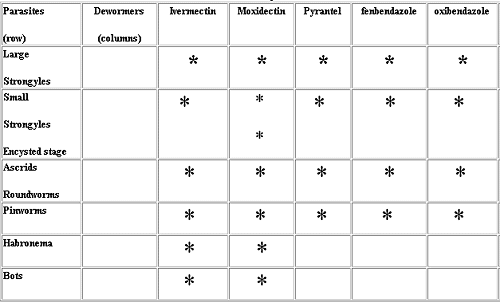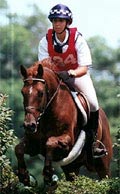 |
 |
|
Worms-Unwanted Invaders by Karen Theis Brown
Your horse lives unaware of the deadly enemies from within.
We all know to worm our horses regularly. But have we really taken a close look at these
dangerous creatures? Some may ask, why is it so important to deworm? Can't I save a little
money by only deworming once a season? What will it really hurt if I don't deworm every 4-6
weeks? Why do I have to rotate dewormer? Aren't all the dewormers pretty much the same?
These questions have crossed many horse owners minds, when they are faced with the costs involved in a good deworming program. To a horse owner who has never looked closely at the
worm issue, these may seem like ligament questions, and concerns. However for the horses health
, the answer is always deworm regularly. The creatures that live within our horses bodies are indeed deadly.
Let's take a look at Ascarids (Roundworms). These are the most common parasite, they infect all
horses, and can do enormous amounts of damage. The ages most effected are foals up to yearlings, and the uncared for geriatric horse. The adult worm is approximately one foot long,
about the size of a really large night crawler. The damage path of the Ascarid is through the
intestinal wall, migrating through the liver into the blood stream, damaging capillaries. Upon
entering the lungs, they damage alveoli (the small sacks which hold air in the lungs), bronchioles,
bronchi, and the trachea. All these lung parts are damaged, as the Ascarid worms it way into the
lungs to be coughed up and swallowed to complete the cycle. After being swallowed they lay
eggs in the intestine. The egg is passed in the fecal matter (manure), and is eaten again by the
horse. It takes 10 weeks for the worm to develop top maturity. The eggs are very resistant to
tough environmental conditions, so they can stay around for a while. The whole cycle takes about
3 months. The worm can cause diarrhea, impaction colic, lung damage (characterized by coughing), developmental and growth delays, poor hair coat, pot belly and a perforated or
ruptured intestine. Heavy infestation of these worms can cause a ball of worms to impact the intestines and perhaps rupture it. Not a pretty picture!
Strongyles (Bloodworms)
Strongyles are the most dangerous of the worms and they effect all horses. They are called blood
worms because of the damage they cause to the blood vessels. The egg is laid in the large intestine
, which then passes out in the fecal matter. The egg develops into a larvae and lives on the
underside of grass blades. The horse ingests it and it goes to the intestine where it burrows through
the intestinal wall and migrates through the body. They damage the blood vesicles, causing blood
clots to form, within the blood vesicle. Moving blood clots are called Thrombus. These thrombus
can move through-out the blood stream causing blockages anywhere in the circulatory system.
These blockages are often fatal. Other damage occurs as impaction of the intestine, and
hemmoragic inflammation, and death. The life cycle varies according to the type of Strongyles.
Strongyles vulgaris: 6 months Strongylus edentatus: 11 months with 1 month in the liver. And
Strongyul equinus: 9 months staying in the abdominal wall for 3 to 4 months. Small Strongyles
have a 3 week life cycle and are much less damaging to the horse. They stay primarily in the small intestine.
Habronema (that's a mouth full!)
Habronema or stomach worms spend part of their life cycle in the common house fly. The larvae
when deposited on wounds by the fly can cause long lasting, slow to heal " summer soars"
Depending on where these soars are, bleach can be use on them to kill the infestation. The larvae
also can cause conjunctivitis if deposited on the eye membranes. The worm in the stomach can cause ulcers of the stomach.
Gastrophilus (Bots)
Bots in the mature state are flies. They are rather large, with a stinger like appendage on their
abdomen. The adult fly will go up to the horse curl it's abdomen forward and spray yellow eggs
onto the horses legs, mane, mouth or wither areas. From there the horse will lick at the eggs, as it
causes itching, and ingest the egg. The egg will stay on the tongue for about 3 to 4 weeks. Then it
migrates to the stomach where it will develop into a larvae, attaching itself on the stomach wall,
sucking nutrients from it. They can stay in the stomach for 10 to 12 months. The larvae are about
the 1/2 to 3/4 inches long and cylinder in shape. They are also ribbed in texture. If the larvae are
not controlled through deworming they can cause stomach ulcers, or rupture. As they migrate to the intestines they can cause impaction.
Oxyuridae (Pinworms)
Pinworms are small round worms, which travel through the small intestine, traveling to the cecum
and colon. They stay in the cecum and colon, maturing to adults. The adult female will migrate out
the anus and lay eggs on the skin surrounding the anus. This causes intense itching, resulting in tail
rubbing and hair loss. The life cycle of the pinworm is 5 months. Treatment of worm infestation is
deworming via chemical dewormer. The dewormer needs to be applied every 4-6 weeks because the worm cycles are on going. As one worm starts through the cycle, another may be half way
through, and still another may be on the tail end of the cycle. There are windows in which wormer
can be most effective, so by worming frequently you are hitting the windows of susceptibility more
often. Thus you maximize the effect on the total worm population at any given time, keeping the infestation at a minimal.
Let's look at some dewormers and their chemical makeup.
 |
As we can see from the table, the various chemical agents have different abilities to kill worms. It
appears that Ivermectin products kill all the worms, and worms do not become resistant to this
chemical. Moxidectin, also has the ability to kill all the worms and have an effect on the encysted
stage of the Small Strongyles. This is apparently unique to this chemical. The other chemicals are
limited in their scope of deworming ability. Therefore, these other chemicals need to be rotated with other chemicals to kill all the worms.
It is important when choosing a dewormer, that you rotate chemical agents, not just brand name.
For example, Safe-guard and Panacur have the same chemical agent, fenbendazole. As we know this agent has limited effect on Bots and Habronema. So these products must be rotated with
Ivermectine or Moxidectin.
Deworming agents and programs can be confusing. We hope our article has helped clear up any questions you have in your quest to have healthy horses.
 About the author... About the author...
America's Horsemastership Programs LLC
America's Horsemastership Programs is a national organization who's
purpose is to provide certified instructors with standardized goals, from which horse management and riding can be taught. The goal of the program is to
provide a means whereby students can systematically grow toward the goal of a certified riding instructor, if they so choose, or to become a competent
rider, trainer and horse manager. The standards offered are in Combined Training, Dressage, Hunter/Jumper, Stock seat/Reining, and Saddle seat.
Horse management must be taught as a part of each riding discipline, however it can also be taught alone as a curriculum.
Contact: Karen Theis Brown
371 Mountain Avenue
Northwood, New Hampshire 03261
Phone: 603-942-8822
Email: qhpucf@ttlc.net |
 |
|
To advertise your horse product or service, contact Ann
|
 |
|
InfoHorse.com, Horse Information Lives Here ® 10/15/2025
Contact Us to Advertise to over a million Horse Owners.
All images and content Copyright© 2012 by InfoHorse.com, Equusite.com.
Horse Owners are Dog Owners; Dog Product Information dognowner.com
|
|
|
Articles, Academic Schools, Arena Maintenance, Animal Communicators, Barns, Barn and Accessories, Barn Equipment and Tractors, Breast Collars, Grooming Products for Horses, Hay Feeders, Horse Blankets, Horse Books, Horse Videos, Horse Breeders, Horse Camping Gear, Career Schools, Carts and Buggies, Horse Training Clinicians, Equestrian Clothing, Dogs and Puppies, Horse Fencing, Western Art & Furniture, Horse Property for Sale, Horse Products For Sale, Fly Control, Foal Care, Horse Footings, Horse Gifts, Horse Health and Nutrition, Hoof and Leg, Horse Insurance, John Lyons Certified Trainers, Equine Lawyers, Leather Care, Links, Horse Property, Horse Photography, Portable Horse Stalls, Arenas and Roundpens, Horse Riding Schools, Horse Schools, Safety Products, Services for Horses, Horse Trailers, Horse Shipping, Horse Skin Coat Care, Horse Software, Specialty Trainers, Horse Summer Camps, Tack, Horse Trainers, Treats and Snacks, Truck Accessories, Trucks, Horse Vacations, Western Lifestyle, jewelry
|
|
|
|